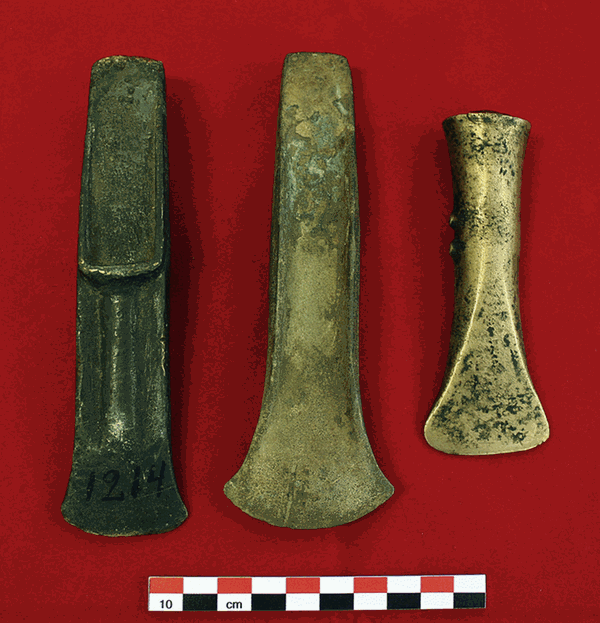Scandinavia’s role in the copper networks of Europe in the 2nd Millennium BC

Bronze axes analysed for lead isotope composition (from Ling et al. 2014)
Summary
Bronze consists primarily of copper with addition of a minor amount of tin, usually around 10 %. Copper ores generally contain a small amount of lead whose isotopic composition varies between different ore districts and different mines due to different age, origin and composition of the ores.
This lead is also found in the bronze objects and by determining its isotopic composition and compare with data from ores in the Nordic countries and elsewhere in Europe it is possible determine where the ore may have been mined.
Within the project a large number of bronze objects are analysed, such as weapons, tools and jewelry as well as ingots and remains from production sites. The isotopic analyses are made with a multi-collector ICP mass spectrometer at the Department of Geosciences. In addition to Pb isotopes, trace elements (Sn, Ni, As, Ag, Sb and others) are analysed with electron microprobe by scientists at Geoarkeologiskt laboratorium in Uppsala.
The artefacts are mainly from Sweden, Denmark and Norway and were produced during the Scandivavian Bronze Age (1700-500 BC). Along with data from archaeological research the aim is to unravel the trade routes between Scandinavia and continental Europe during the Bronze Age.
This research is funded by Vetenskapsrådet (the Swedish Research Council)
Project participants at the museum
External project participants
- Johan Ling, Institute of Archaeology, University of Gothenburg
- Lena Grandin, Geoarkeologiskt laboratorium, Uppsala
- Eva Hjärthner-Holdar, Geoarkeologiskt laboratorium, Uppsala
Selected publications
- Ling, J., Hjärthner-Holdar, E., Grandin, L., Billström, K. & Persson, P.-O.: Moving metals or indigenous mining? Provenancing Scandinavian Bronze Age artefacts by lead isotopes and trace elements. Journal of Archaeological Science 40 (2013), 291-304.
- Johan Ling , Zofia Stos-Gale, Lena Grandin, Kjell Billström, Eva Hjärthner-Holdar, Per-Olof Persson: Moving metals II: provenancing Scandinavian Bronze Age artefacts by

lead isotope and elemental analyses. Journal of Archaeological Science 41 (2014) 106-132.


